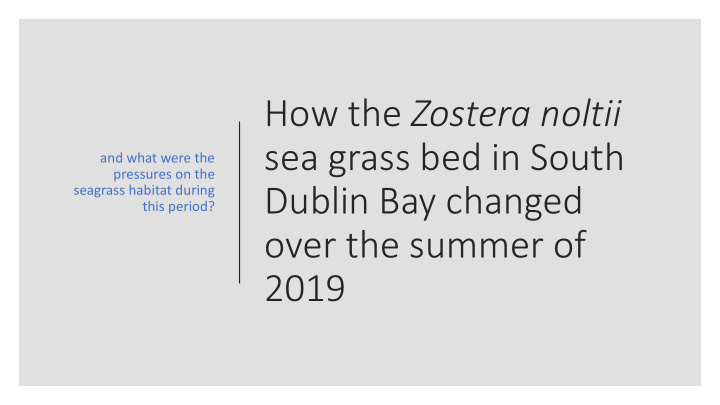



How the Zostera noltii sea grass bed in South and what were the pressures on the seagrass habitat during Dublin Bay changed this period? over the summer of 2019
• Carbon sequestration • 35 times quicker than rainforest • Sediment trapping • Prevents erosion • Nursery ground for other species Why is it • Shrimps, small fish important? • Food for Brent Geese • Nutritious, protein rich • Water quality indicator in the Water Framework Directive • Indicative of water quality
Brent Feeding on the seagrass Geese
• First official record: 1954 • In 1983 approx. 1.4 ha Zostera noltii • In 1993 approx. 1.75 ha starting 10-20 m seagrass on from the seawall protecting houses • In July 2019 approx. 1.8 ha starting 5 m Merrion from the seawall • One of only two locations in the Dublin area strand
Heat Blackened brittle blades in the seagrass bed stress
Unhealthy seagrass Healthy seagrass envrionment environment
Green opportunistic seaweed • Grows in long strands attached to a razorfish shell or a cockle • The loose end of the strand floats freely in the high tide • Unattached seaweed and other loose debris get attached to the strand • When the strand gets too heavy it breaks free and floats off with the tide • When the tide recedes again the seaweed mould descends on the sediment • Anaerobic conditions occur
Anaerobic sediment
Direct Disturbance People & Dogs Vehicles Litter
Sewage overflow Sanitary litter Can cause nutrient enrichment
Theme 1: Strengthen the knowledge base of decision- makers for the conservation and management of biodiversity, and protect species and habitats of conservation value within Dublin City
Act ctio ion 2: Continue to map the distribution, and assess the abundance and conservation status Recommendations: - Yearly survey of the Zostera noltii bed - Intertidal mudflat temperature measurement during heatwaves and development of anaerobic mud, and fate of mud snails ( Hydrobia spp. ) - Sediment samples taken for analysis - Measurement of nutrient levels in the freshwater stream - Monitoring of the growth of Salicornia europaea and the formation of a new lagoon
Actio ion 3: Develop site-specific best management guidelines for legally protected species within Dublin City, and communicate with landowners and users Recommendations: - Design and put up new signage in locations closer to the seagrass bed - involve the Sandymount and Merrion Residents association and local residents, as they are very knowledgeable and interested in protecting the Zostera noltii bed.
Thank you ! Rita Hagan rhagan100@gmail.com 087-7512955
Recommend
More recommend